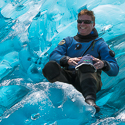[caption id="attachment_3750" align="aligncenter" width="523"]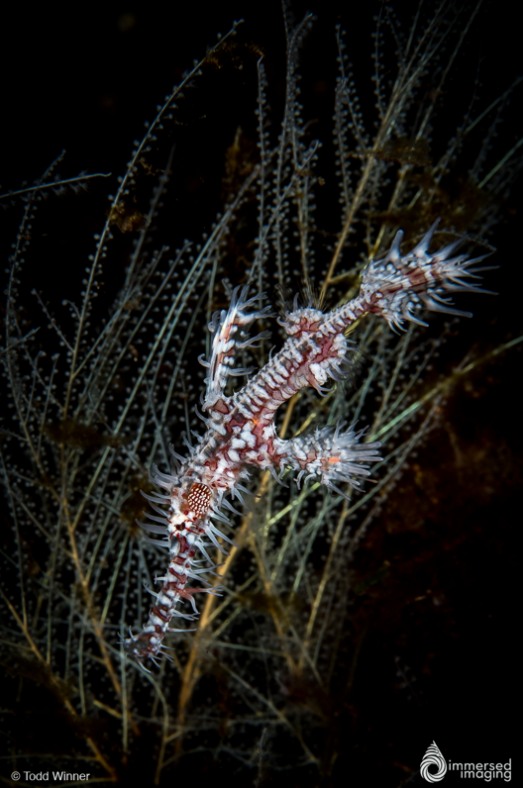 Ornate Gost Pipefish, Canon 5DS R, EF 100mm Macro, 1/200. f/18, ISO 160 | Credit: Todd Winner[/caption]
I often get new photographers that sign up for a local trip or one of our photo workshops that are struggling to get good underwater macro shots. Nine times out of ten they have their camera set to one of the auto exposer modes. Unfortunately, these rarely work well for macro underwater. There is just not enough light at depth to typically illuminate a tiny subject on the reef. When you use one of the auto modes to shoot these type of images, the camera’s light meter thinks it should open the aperture, slow down the shutter speed or increase the ISO. This is not what you want for most underwater macro shots.
[caption id="attachment_3749" align="aligncenter" width="640"]
Ornate Gost Pipefish, Canon 5DS R, EF 100mm Macro, 1/200. f/18, ISO 160 | Credit: Todd Winner[/caption]
I often get new photographers that sign up for a local trip or one of our photo workshops that are struggling to get good underwater macro shots. Nine times out of ten they have their camera set to one of the auto exposer modes. Unfortunately, these rarely work well for macro underwater. There is just not enough light at depth to typically illuminate a tiny subject on the reef. When you use one of the auto modes to shoot these type of images, the camera’s light meter thinks it should open the aperture, slow down the shutter speed or increase the ISO. This is not what you want for most underwater macro shots.
[caption id="attachment_3749" align="aligncenter" width="640"]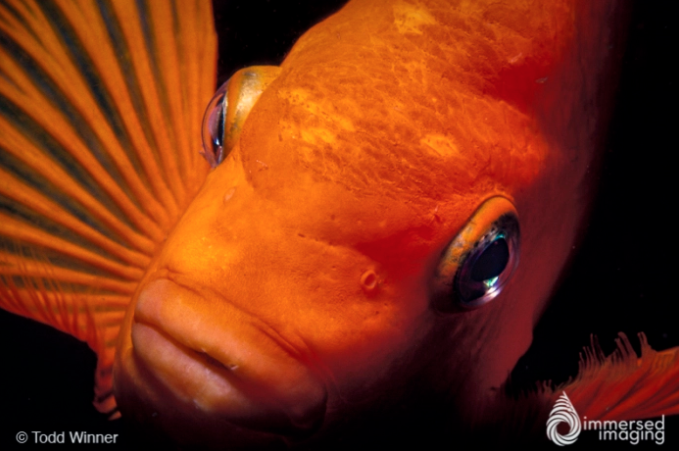 Garibaldi #1, This is one of my first underwater images shot over 20 years ago with one strobe and a Nikonos V film camera, 35mm with ext. tubes. | Credit: Todd Winner[/caption]
Fortunately, the solution is quite simple. Here are some good settings to start with. First, set your camera to manual exposer. Next, set a low ISO, 200 is good. Set your aperture to f/18 on a DSLR or f/4 on a compact. Set a fast shutter speed that will still sync with your strobes somewhere around 200th of a second. If you fire off a frame, chances are you will get solid black and if you look at your light meter it will be blinking under-exposer warnings. This is exactly what we want. Almost every underwater macro you have ever seen is entirely lit by strobes. So let’s take a look at how to properly expose an image with our strobes.
[caption id="attachment_3748" align="aligncenter" width="640"]
Garibaldi #1, This is one of my first underwater images shot over 20 years ago with one strobe and a Nikonos V film camera, 35mm with ext. tubes. | Credit: Todd Winner[/caption]
Fortunately, the solution is quite simple. Here are some good settings to start with. First, set your camera to manual exposer. Next, set a low ISO, 200 is good. Set your aperture to f/18 on a DSLR or f/4 on a compact. Set a fast shutter speed that will still sync with your strobes somewhere around 200th of a second. If you fire off a frame, chances are you will get solid black and if you look at your light meter it will be blinking under-exposer warnings. This is exactly what we want. Almost every underwater macro you have ever seen is entirely lit by strobes. So let’s take a look at how to properly expose an image with our strobes.
[caption id="attachment_3748" align="aligncenter" width="640"]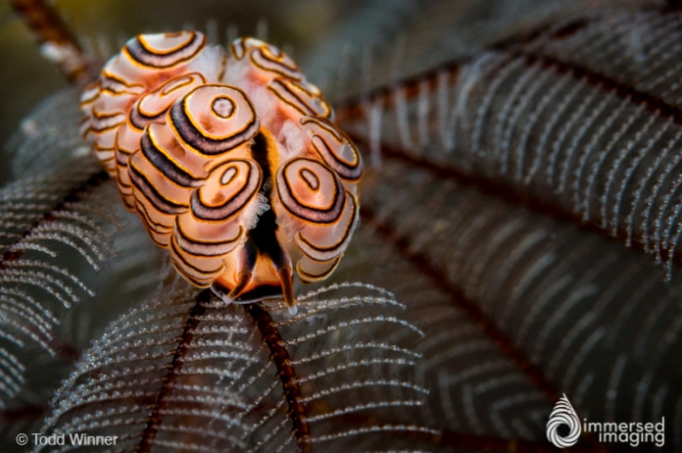 Doto Greenamyeri Donut Nudibranch, Canon 5DS R, EF 100mm Macro, 1/200, f/16, ISO 160 | Credit: Todd Winner[/caption]
If you have a camera, housing and strobes that support it, you could just set it to TTL and fire away. As long as your strobes are aimed correctly and are close enough you should get properly exposed frames. But this is a great time to learn how to use manual strobes. If you have never shot manual strobes I would start with one. Just turn off your second strobe if you have one. Position the strobe over and as close as you can to your port and aim forward. This is going to give you pretty flat lighting but you can start moving the strobe once you learn manual strobe exposer. Start with your strobe set to 1/2 or 3/4 power. You are going to be close to your macro subject but make sure you are at least 18 inches or closer. At this distance you shouldn’t have to change any camera settings with most strobes. You can increase ISO or open up the aperture if you are not getting enough light, but please work with these settings first. Take a shot and review the image. If the image is too dark increase the strobe power, move closer, or reposition the strobe. If the image is too bright you are probably already close enough and the strobe is aimed properly so decrease strobe power. Once you are getting consistent results start moving the strobe for more interesting lighting and shadows. If you have a second strobe you can start adding that back in. Remember they don’t need to be at the same power. You can use one just to fill in the shadows. Just experiment and have fun!
[caption id="attachment_3751" align="aligncenter" width="523"]
Doto Greenamyeri Donut Nudibranch, Canon 5DS R, EF 100mm Macro, 1/200, f/16, ISO 160 | Credit: Todd Winner[/caption]
If you have a camera, housing and strobes that support it, you could just set it to TTL and fire away. As long as your strobes are aimed correctly and are close enough you should get properly exposed frames. But this is a great time to learn how to use manual strobes. If you have never shot manual strobes I would start with one. Just turn off your second strobe if you have one. Position the strobe over and as close as you can to your port and aim forward. This is going to give you pretty flat lighting but you can start moving the strobe once you learn manual strobe exposer. Start with your strobe set to 1/2 or 3/4 power. You are going to be close to your macro subject but make sure you are at least 18 inches or closer. At this distance you shouldn’t have to change any camera settings with most strobes. You can increase ISO or open up the aperture if you are not getting enough light, but please work with these settings first. Take a shot and review the image. If the image is too dark increase the strobe power, move closer, or reposition the strobe. If the image is too bright you are probably already close enough and the strobe is aimed properly so decrease strobe power. Once you are getting consistent results start moving the strobe for more interesting lighting and shadows. If you have a second strobe you can start adding that back in. Remember they don’t need to be at the same power. You can use one just to fill in the shadows. Just experiment and have fun!
[caption id="attachment_3751" align="aligncenter" width="523"]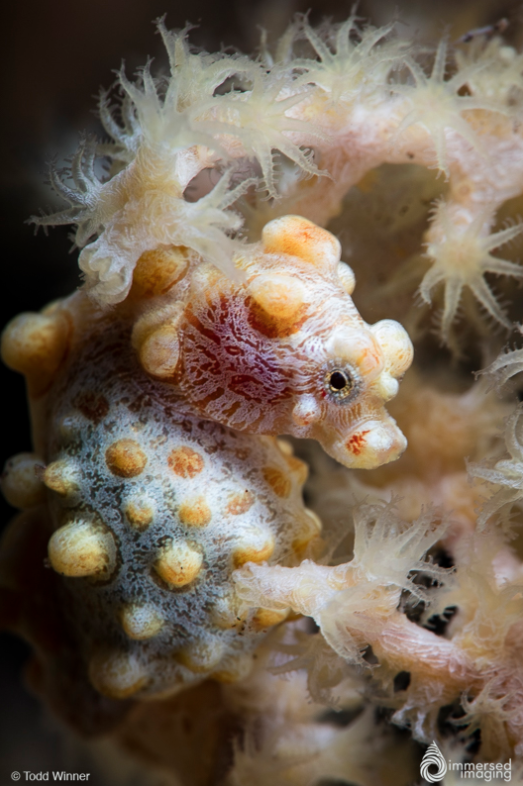 Pygmy Seahorse, Canon 5DS R, EF 100mm Macro 1/200, f18, !SO 160 | Credit: Todd Winner[/caption]
Pygmy Seahorse, Canon 5DS R, EF 100mm Macro 1/200, f18, !SO 160 | Credit: Todd Winner[/caption]
 Ornate Gost Pipefish, Canon 5DS R, EF 100mm Macro, 1/200. f/18, ISO 160 | Credit: Todd Winner[/caption]
I often get new photographers that sign up for a local trip or one of our photo workshops that are struggling to get good underwater macro shots. Nine times out of ten they have their camera set to one of the auto exposer modes. Unfortunately, these rarely work well for macro underwater. There is just not enough light at depth to typically illuminate a tiny subject on the reef. When you use one of the auto modes to shoot these type of images, the camera’s light meter thinks it should open the aperture, slow down the shutter speed or increase the ISO. This is not what you want for most underwater macro shots.
[caption id="attachment_3749" align="aligncenter" width="640"]
Ornate Gost Pipefish, Canon 5DS R, EF 100mm Macro, 1/200. f/18, ISO 160 | Credit: Todd Winner[/caption]
I often get new photographers that sign up for a local trip or one of our photo workshops that are struggling to get good underwater macro shots. Nine times out of ten they have their camera set to one of the auto exposer modes. Unfortunately, these rarely work well for macro underwater. There is just not enough light at depth to typically illuminate a tiny subject on the reef. When you use one of the auto modes to shoot these type of images, the camera’s light meter thinks it should open the aperture, slow down the shutter speed or increase the ISO. This is not what you want for most underwater macro shots.
[caption id="attachment_3749" align="aligncenter" width="640"] Garibaldi #1, This is one of my first underwater images shot over 20 years ago with one strobe and a Nikonos V film camera, 35mm with ext. tubes. | Credit: Todd Winner[/caption]
Fortunately, the solution is quite simple. Here are some good settings to start with. First, set your camera to manual exposer. Next, set a low ISO, 200 is good. Set your aperture to f/18 on a DSLR or f/4 on a compact. Set a fast shutter speed that will still sync with your strobes somewhere around 200th of a second. If you fire off a frame, chances are you will get solid black and if you look at your light meter it will be blinking under-exposer warnings. This is exactly what we want. Almost every underwater macro you have ever seen is entirely lit by strobes. So let’s take a look at how to properly expose an image with our strobes.
[caption id="attachment_3748" align="aligncenter" width="640"]
Garibaldi #1, This is one of my first underwater images shot over 20 years ago with one strobe and a Nikonos V film camera, 35mm with ext. tubes. | Credit: Todd Winner[/caption]
Fortunately, the solution is quite simple. Here are some good settings to start with. First, set your camera to manual exposer. Next, set a low ISO, 200 is good. Set your aperture to f/18 on a DSLR or f/4 on a compact. Set a fast shutter speed that will still sync with your strobes somewhere around 200th of a second. If you fire off a frame, chances are you will get solid black and if you look at your light meter it will be blinking under-exposer warnings. This is exactly what we want. Almost every underwater macro you have ever seen is entirely lit by strobes. So let’s take a look at how to properly expose an image with our strobes.
[caption id="attachment_3748" align="aligncenter" width="640"] Doto Greenamyeri Donut Nudibranch, Canon 5DS R, EF 100mm Macro, 1/200, f/16, ISO 160 | Credit: Todd Winner[/caption]
If you have a camera, housing and strobes that support it, you could just set it to TTL and fire away. As long as your strobes are aimed correctly and are close enough you should get properly exposed frames. But this is a great time to learn how to use manual strobes. If you have never shot manual strobes I would start with one. Just turn off your second strobe if you have one. Position the strobe over and as close as you can to your port and aim forward. This is going to give you pretty flat lighting but you can start moving the strobe once you learn manual strobe exposer. Start with your strobe set to 1/2 or 3/4 power. You are going to be close to your macro subject but make sure you are at least 18 inches or closer. At this distance you shouldn’t have to change any camera settings with most strobes. You can increase ISO or open up the aperture if you are not getting enough light, but please work with these settings first. Take a shot and review the image. If the image is too dark increase the strobe power, move closer, or reposition the strobe. If the image is too bright you are probably already close enough and the strobe is aimed properly so decrease strobe power. Once you are getting consistent results start moving the strobe for more interesting lighting and shadows. If you have a second strobe you can start adding that back in. Remember they don’t need to be at the same power. You can use one just to fill in the shadows. Just experiment and have fun!
[caption id="attachment_3751" align="aligncenter" width="523"]
Doto Greenamyeri Donut Nudibranch, Canon 5DS R, EF 100mm Macro, 1/200, f/16, ISO 160 | Credit: Todd Winner[/caption]
If you have a camera, housing and strobes that support it, you could just set it to TTL and fire away. As long as your strobes are aimed correctly and are close enough you should get properly exposed frames. But this is a great time to learn how to use manual strobes. If you have never shot manual strobes I would start with one. Just turn off your second strobe if you have one. Position the strobe over and as close as you can to your port and aim forward. This is going to give you pretty flat lighting but you can start moving the strobe once you learn manual strobe exposer. Start with your strobe set to 1/2 or 3/4 power. You are going to be close to your macro subject but make sure you are at least 18 inches or closer. At this distance you shouldn’t have to change any camera settings with most strobes. You can increase ISO or open up the aperture if you are not getting enough light, but please work with these settings first. Take a shot and review the image. If the image is too dark increase the strobe power, move closer, or reposition the strobe. If the image is too bright you are probably already close enough and the strobe is aimed properly so decrease strobe power. Once you are getting consistent results start moving the strobe for more interesting lighting and shadows. If you have a second strobe you can start adding that back in. Remember they don’t need to be at the same power. You can use one just to fill in the shadows. Just experiment and have fun!
[caption id="attachment_3751" align="aligncenter" width="523"] Pygmy Seahorse, Canon 5DS R, EF 100mm Macro 1/200, f18, !SO 160 | Credit: Todd Winner[/caption]
Pygmy Seahorse, Canon 5DS R, EF 100mm Macro 1/200, f18, !SO 160 | Credit: Todd Winner[/caption]





